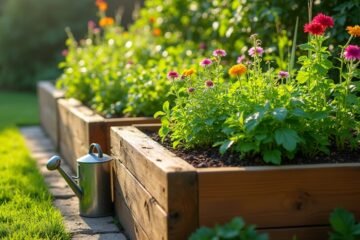Want a garden that thrives all year? Start in winter by planning cozy corners and sketching layouts! When late winter rolls in, it’s time to start seeds indoors—think of those little green soldiers waiting to burst forth! As spring arrives, prepare beds and plant cool-weather crops like crisp lettuce and crunchy radishes. Don’t forget to mulch in summer to keep weeds at bay! Curious about how to keep your garden flourishing? There’s so much more to discover!
Planning and Designing Your Garden in Winter
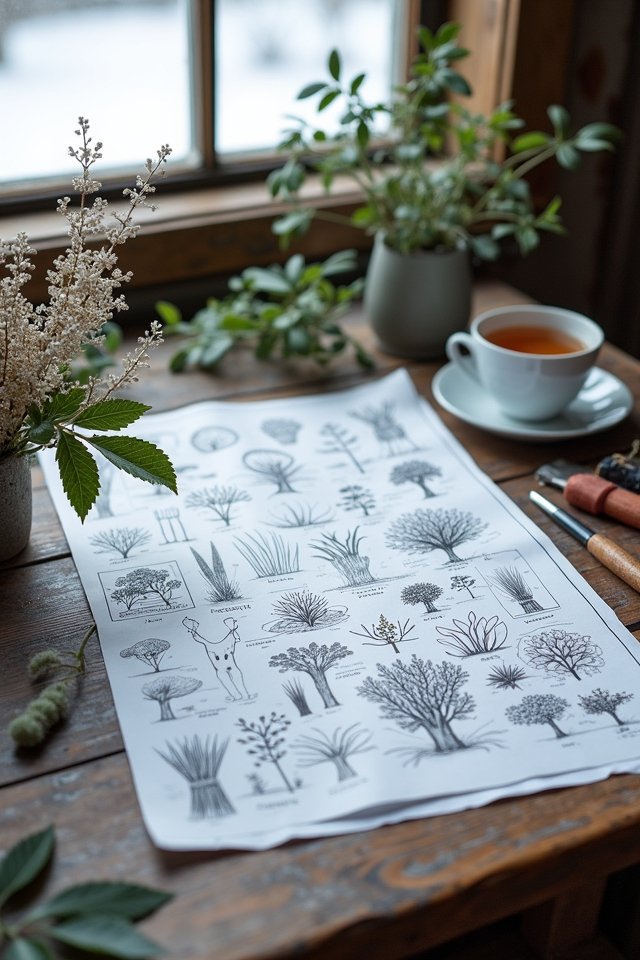
As winter blankets the ground, you might think gardening’s come to a halt, but that’s far from the truth! This is the perfect time to get creative with your garden layout. Picture vibrant spring blooms against a backdrop of glittering frost! Start by visualizing how seasonal colors will dance together, creating a masterpiece that ignites joy as warm weather approaches. Sketch out your design, pondering cozy corners for lounging, raised beds for veggies, or whimsical pathways weaving through flowering bushes. Don’t forget to contemplate textures, too—think soft ferns beside sturdy, bright tulips! By planning now, you’ll guarantee every daffodil and cherry blossom has its moment to shine. Ready to craft your winter wonderland? Let’s make those dreams blossom!
Starting Seeds Indoors in Late Winter
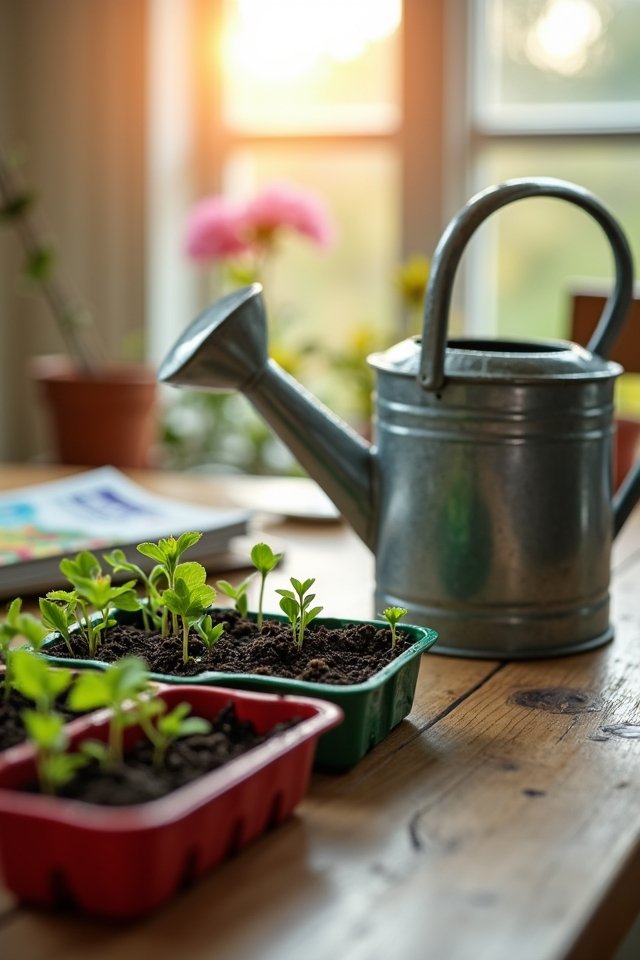
Winter’s still surrounding us, but don’t let that snow-covered landscape fool you—spring is just around the corner! It’s time to get excited about starting seeds indoors! First, think about your seed selection; go for innovative varieties that will thrill your garden later. Now, grab some seed trays, soil, and set them up near your indoor lighting. Natural light won’t cut it, so use grow lights to provide those seedlings with the radiant sunshine they crave. Keep the soil moist, but not soggy—think of it as showering them, not drowning! As the days pass, you’ll witness those tiny green shoots poke through the soil like enthusiastic little soldiers, ready to take on the world. Isn’t that just delightful?
Preparing Garden Beds for Early Spring
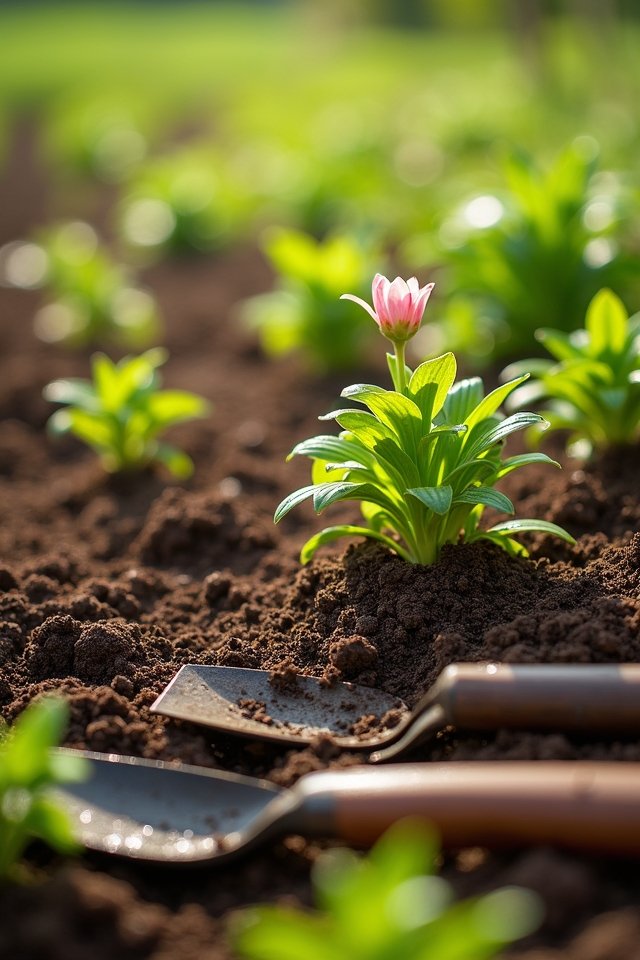
Once the chill of winter starts to wane, it’s time to roll up your sleeves and prepare your garden beds for early spring! First, dig into soil testing—like a doctor checking your garden’s health. Get to know its pH and nutrients. This knowledge is your secret weapon! Once you’ve got that info, it’s bed amendment time! Mix in organic compost or well-rotted manure, turning those tired, clumpy clods into fluffy, nutrient-rich beds that plants can’t resist. Picture your future harvest thriving in this rich environment! And remember, loosen any stubborn soil compaction; think of it as giving your plants a cozy blanket. With a little elbow grease, you’re setting the stage for a stunning, bountiful season ahead!
Planting Cool-Weather Crops in Spring

After prepping those luscious garden beds, it’s prime time to roll up your sleeves and get planting! Spring is the perfect season for those cool weather varieties that just love the brisk air. Picture your garden brimming with:
- Crisp, emerald lettuce leaves, ready for a fresh salad
- Vibrant radishes, their bright colors popping against the soil
- Fragrant peas, climbing and twirling happily on their supports
As you dig into spring planting, don’t forget to soak those seeds overnight for a head start! It’s a thrill to watch your efforts turn into a beautiful tapestry of colors and tastes. Welcome these cool-weather crops, and soon enough, you’ll enjoy bountiful harvests that’ll have you grinning from ear to ear! Happy planting!
Mulching and Weeding in Early Summer

As the sun grows warmer and the garden bursts into life, it’s essential to tackle mulching and weeding to keep your plants happy and thriving! Think of mulch as a cozy blanket for your soil, helping retain moisture and suppress weeds—talk about multitasking! By applying a thick layer around your plants, you’ll not only beautify your garden but also boost those mulch benefits, like temperature regulation.
But wait, weeding isn’t just a chore; it’s your secret weapon for wonderful weed control! Those pesky invaders can steal nutrients, so grab your weeder and demonstrate who’s boss. As you pull them out, visualize your plants stretching their roots, sighing in relief! So jump in—your garden’s about to flourish like never before!
Managing Pests and Diseases in Mid-Summer
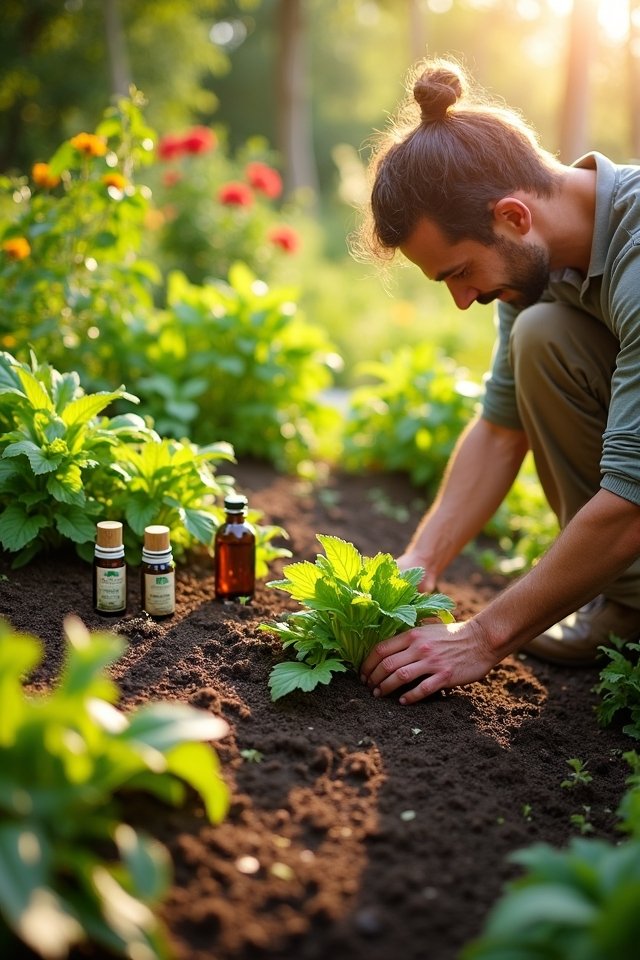
Your garden’s vibrant growth might attract a few uninvited guests! Mid-summer is the time to combat pests and diseases, ensuring your plants stay healthy and flourishing. Think of it like hosting a party where you want only the best guests—let’s invite natural predators to the celebration!
Consider these organic treatments:
- Neem oil for a delightful, citrusy scent and effective pest control.
- Diatomaceous earth that’s like a fine powdery fortress against bugs.
- Companion planting that’s akin to strategic seating arrangements—pairing plants to repel unwanted visitors!
Stay vigilant! With a little observation and creativity, you can outsmart pests with nature’s finesse. Who knew managing your garden could be this thrilling? Enjoy the adventure!
Harvesting and Continuous Planting in Late Summer
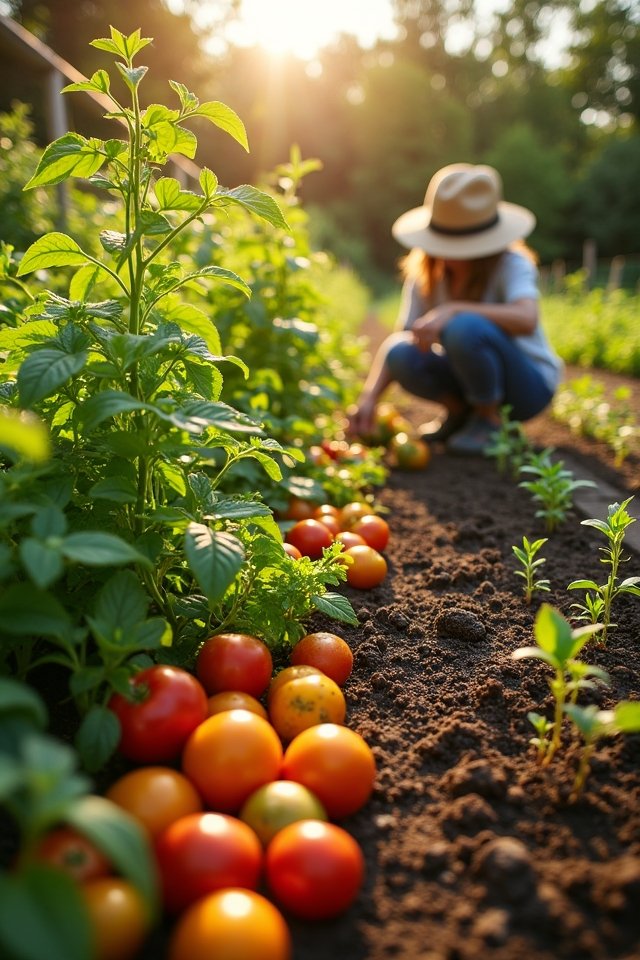
Summer’s golden days are winding down, but your garden isn’t quite ready to say goodbye! Late summer is the perfect time to reap bountiful harvests and keep the planting spirit alive. As you gather ripe tomatoes and juicy cucumbers, think of crop rotation like giving your garden a rejuvenating makeover. Try sowing quick-growing greens, like arugula and spinach, right after you harvest those summer veggies! They’ll flourish in the warm days and cooler nights. Ever consider planting a fall variety of carrots? They’ll surprise you with their sweetness! So grab that trowel, and let’s think innovatively! Why not plant a few flowers too? Your garden deserves a vibrant farewell—how about a splash of color as summer waves goodbye?
Preparing for Fall Planting and Winterization
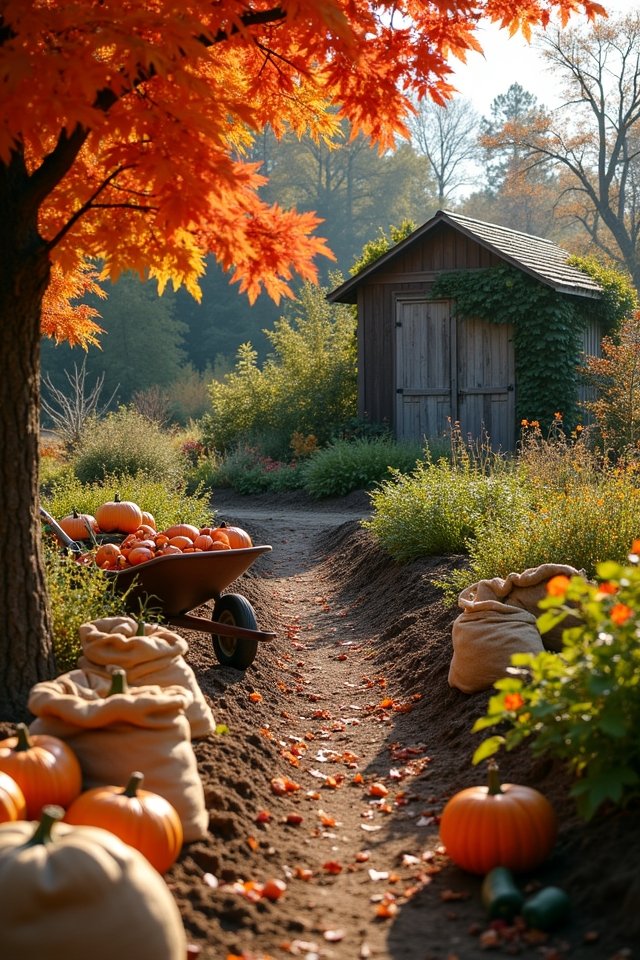
While the days grow shorter and the air gets crisp, it’s time to roll up your sleeves and prepare for fall planting! Picture vibrant fall crops bursting with flavor, just waiting to delight your taste buds. To set the stage for success, consider these essential tasks:
- Clear your garden beds of summer remnants, leaving room for fresh growth.
- Select winter protection options, like row covers or mulch, to shield your plants from frost.
- Gather up seeds for hearty vegetables, such as kale, carrots, and radishes, that thrive in cooler temperatures.
Welcome this season’s excitement as you usher in your fall garden! With your proactive prep, you’ll turn that crisp air into a warm welcome of colorful harvests come winter!
Adding Compost and Nutrients in Fall
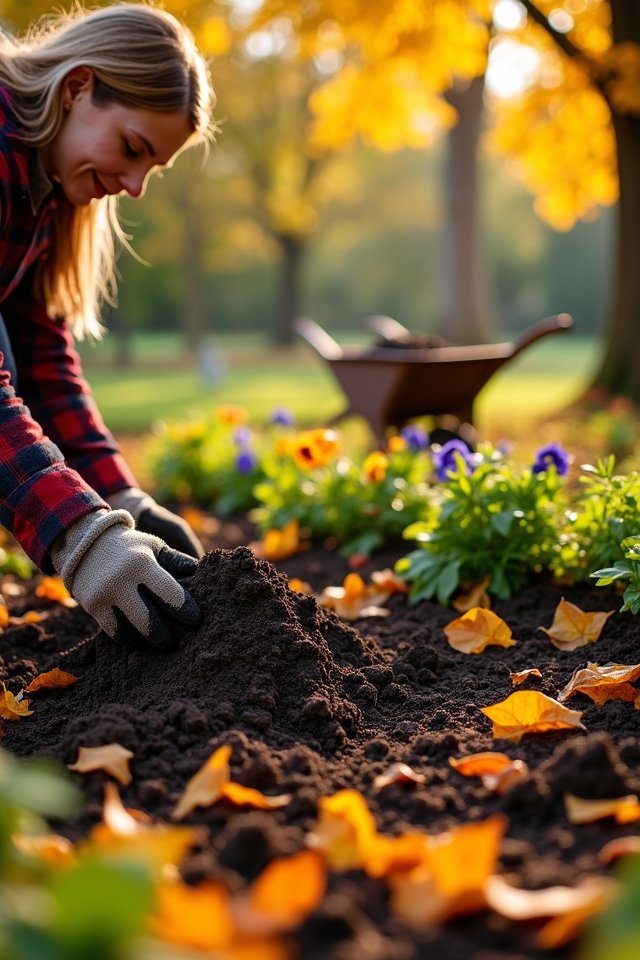
As the leaves start to paint the ground with their colorful tapestry, now’s your golden opportunity to boost your soil health! Fall composting is your secret weapon. Imagine this: you’re layering nutrient-rich compost like a cozy blanket for your garden, snuggling in all those valuable vitamins. Want to achieve nutrient balancing? Mix in some bone meal or rock phosphate to give your soil the autumn hug it craves! Don’t forget to sprinkle in a bit of organic matter, too—it’s like giving your plants a delightful feast before winter. Grab your shovel and let the magic unfold! Remember, a thriving garden in spring starts with the care you invest in the fall. Let’s dig in and make your soil dance with joy!
Monitoring and Pruning During Dormancy in Winter

Even though winter may seem like a sleepy time for your garden, there’s plenty to do! Immerse yourself in dormant pruning and keep your plants in check. While the frost settles, grab your pruning shears and mindfully shape your trees and shrubs. Here are a few tasks to reflect on:
- Inspect for any signs of disease: Be the detective in your garden, spotting those sneaky issues!
- Remove dead or damaged limbs: Say goodbye to the old and make way for the new!
- Winter monitoring: Keep an eye on your garden’s health; look for critters sneaking around!
Get creative—this is your chance to breathe life into your garden before spring! Let your pruning adventure unfold this winter!
Frequently Asked Questions
What Tools Are Essential for Year-Round Gardening Success?
You’ve gotta have the right gardening tools for success year-round! Think shears that slice through branches like butter, a sturdy trowel to dig deep into the earth, and a comfy kneeler to protect those knees during seasonal maintenance. Don’t forget a hose with a sprayer, ensuring your plants feel refreshed and rejuvenated! With these tools by your side, you’ll transform your garden into a vibrant oasis, no matter the season. Ready to dig in?
How Can I Save Seeds From My Garden?
Saving seeds from your garden’s bounty is like bottling up sunshine for next season! First, choose your best plants for seed selection; they’re your champions! Let them ripen fully, then harvest those seeds. Once you’ve got them, dry ’em out—think crispy, not crunchy! Store your treasures in cool, dark places. You can even use fun jars or envelopes! Imagine the thrill of planting your homegrown wonders again—what a joy!
Which Plants Are Best for Companion Planting?
Imagine your garden as a symphony, where companion plants harmonize beautifully! Some of the best plant pairings? Basil and tomatoes are a classic duo, boosting flavor and deterring pests. Carrots and onions? They’re like best friends who keep each other safe from pesky critters! Using smart planting strategies, you’ll create a thriving ecosystem buzzing with life. So, ready to mix and match for a stunning display? Your garden deserves its own masterpiece!
How Can I Improve Soil Quality Over Time?
Want to boost your soil quality over time? Start with a soil amendment extravaganza! Think of compost as your soil’s delicious feast—it’s packed with nutrients that encourage healthy plant growth. Mixing in things like aged manure or green cover crops can work wonders too. Imagine your soil transforming into a rich, dark chocolate cake! So, get those organic materials in there, and watch your garden flourish like never before! How exciting is that?
What Are the Best Practices for Organic Pest Control?
When it comes to organic pest control, you’ve got some fantastic options! Think of natural repellents as your garden’s invisible shield. For example, garlic spray can deter pesky aphids. Plus, attracting beneficial insects, like ladybugs and lacewings, brings in nature’s own army. They’ll feast on harmful pests, keeping your plants happy! Isn’t that cool? So, armed with these tips, you’ll create a thriving garden—pest-free and envied by all! Let’s dig in!

